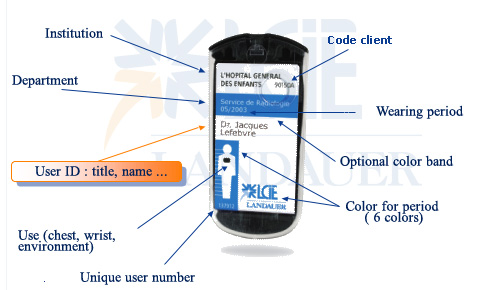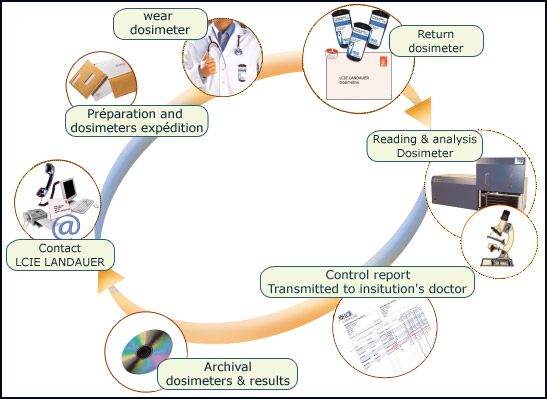Portable dosimeters for monitoring of exposed people

Individual passive dosimeters
The port and the reading of a dosimeter are individualized. The sensor itself is in a box that contained all the information that can identify the holder (name, department, institution), the use and wearing period. Among the more common passive are the OSL (Optically Stimulated Luminescence) like this InLight model of LCIE Landauer that ensures the production and follow-up..
© LCIE Landauer
Dosimeters called passive are dosimeters that do not need an external source of energy to operate. They are integrating dosimeters : they give only an estimate of an overall cumulated dose. They do not measure instantaneous doses, unlike active dosimeters that are able to follow the variations of the exposure.
They are regulatory dosimeters that must be worn on the chest by workers that may be exposed to ionizing radiation. Passive dosimeters make it possible to estimate their exposure received over time.
The risks of certain professional activities require adequate dosimetric monitoring, when the indication provided by chest dosimeters is not sufficient. For instance, extremity dosimeters are recommended when hands, are particularly exposed to radiation. Wear a crystalline dosimeter is also necssary in the case of potential eye lens exposure to ionizing radiation.

The cycle of monitoring dosimeters
Monitoring personal exposure to radiations (nuclear power plants, hospitals, etc.) requires an individualized management of dosimeters, as shown by the example of “InLight” OSL dosimeters of LCIE Landauer company. After having been worn, the dosimeter is read and analyzed. Results are recorded and forwarded to the appropriate physician. OSL dosimeter reading is not destructive and dosimeter can be returned to the establishment to be used again.
© LCIE Landauer
Passive dosimeters are worn by workers during a monthly or quarterly period. At the end of this period, the dosimeter is read and analyzed by an approved laboratory specialized in radioprotection. In France main laboratories are LCIE Landauer, IRSN …) The Regulations require that the nominative results are transmitted to radioprotection advisers and to the occupational doctor following the exposed staff, and if necessary to the personal physician of the employee. In addition, the data is transmitted to the central database managed by the supervisory control authority..
There are dosimeters specific for beta rays, X and gamma rays. There are also dosimeters for neutrons.
Dosifilms or film-badges were the most used individual dosimeters until the early 2000s. They were the first passive dosimeters to have been developed. Derived from photographic techniques, the same ones which allowed the discovery of radioactivity by Becquerel in 1896, they tend to disappear owing the current decline of argentic films. Dosifilms are also no longer sufficiently sensitive in the eyes of current regulations.
Dosifilms are gradually replaced by dosimeters using more efficient and modern technologies measuring the light emission or luminescence of the irradiated detector. The technologies used for measuring luminescence are OSL (Optically Stimulated Luminescence), RPL (Radio Photo Luminescence) and TLD (Thermo Luminescence). The luminescence is triggered by a light flash in the case of the OSL and RPL and heating for TLD.
The OSL, RPL and TLD dosimeters are, to date, passive dosimetry techniques recognized by the French legislation. These new techniques make it possible to register exposures lower than 100 μSv (NB: 100 microsieverts are equivalent to 15 days of natural radioactivity).
Today, in 2018, the IRSN Dosimetry Laboratory carries out approximately 1,200,000 annual RPL dosimeter analyzes. Most of these are individual RPL dosimeters, but there are also room dosimeters for workplaces, job dosimeters used to study the radiation environment before a new task is started. (NB : IRSN is the french Institute of Radioprotection and Nuclear Safety)
Other articles on the subject « Dosimetry »
OSL Dosimeters
Dosimetry by “Optically stimulated luminescence” The active element of an OSL [...]
RPL Dosimeters
Sensitive, robust and widely used dosimeters These passive dosimeters use radiophotoluminescence [...]
TLD Dosimeters
Exploit thermoluminescence for dosimetry The energy provided by ionizing radiation may cause defe[...]
Active Dosimeters
For real-time monitoring of workers exposed to radiation Active dosimeters are in fact ele[...]